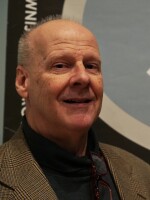
Museum curators usually build an art exhibition around a particular artist's work or on a theme. But the Rockford Art Museum's Midwestern Biennial has an outside judge, lots of different artists and no theme. So how do you curate that?
As Museum Curator Carrie Johnson explains, the Midwestern Biennial poses particular challenges. Normally, she spends up to two years vetting artists, assembling works, and picking a theme.
"So by the time that I get into an installation," she said, "I have a very good idea of what the show is going to look like, or what direction I want it to go in."
But with the Midwestern, there's a juror - a guest curator - who picks the pieces. When they come in not long before the show, it's the first time Johnson will have seen them.
"And I have to try to make all of these pieces work," she said. "So it's kind of like a puzzle, figuring out how to make close to 70 pieces by 70 artists work cohesively."
It is a dizzying array – paintings, sculpture, oils, fabric, plastic, abstract, realist, surrealist -- you name it. But she called it a wonderful challenge to have dropped in her lap.
Johnson's solution to the dilemma involves a mix of expertise and lots of trial-and-error. First, she lays out all the pieces on foam blocks around the gallery. Then she waits until everyone has left, and she's alone with the art.

"I can put headphones in, and it's just my time to try to make these stories and make these pieces connect," she said. "So I’m just constantly moving pieces all around and seeing what works together. And it's a long process. But you kind of work wall by wall."
Only once she's satisfied that she found the best placement can she move on to hanging and lighting them.
"It's really kind of cathartic in a way," she said, "that you're getting to, you know, experience all these different artists' work and try and put it in its best light."
Johnson's not the only one challenged by the exhibit.
Jerry Franklin is a museum volunteer. He leads tours of the shows put on by the museum. Usually, he said, that means researching a particular artist, looking for interesting nuggets about their life and work. With 69 artists from seven states in this show, that's difficult. At the same time, he said, the Midwestern gives him more chances to learn - and pass along - something new, like an art medium he's never heard of before.
"Such as glassine, g-l-a-s-s-i-n-e, done on this paper by Mary Porterfield," he said. "It's a soft tissue that I've never experienced having an artist draw on before. So I research that and try to instruct whoever I'm giving a tour to what that's like."

The work he's describing, "In Silence," depicts several elderly women, really several views of one woman, lying on the ground. Porterfield said she partly based it on her experience as a physical therapist dealing with people who had fallen and had been stranded, as it were, for hours or even days. The piece won the exhibition's Dean Alan Olson Purchase Prize, and will be bought by the museum for its permanent collection.
Porterfield said, the award aside, being part of a big show like the Midwestern is beneficial on several levels.
"It really elevates your art career and validates your credentials," she said. "And that's so helpful when you apply for solo exhibitions, for other juried shows, for grants [and] for artist residencies."
Then there's the fact that shows like this bring together so many artists from such a big region.
"Being able to meet them," she said, "and expand your audience base, and also meet collectors and art enthusiasts - it's an invaluable opportunity."
That's not to say the process isn't stressful.

"For every show an artist gets in," Porterfield said, "there's often many rejections, and you just have to have a tough skin and you just have to keep being persistent and keep pushing yourself forward and not give up."
She's certainly not. Porterfield said she'll continue to enter her work in juried shows whenever and wherever she can.
And as a bonus, she said, they've led to new friendships with fellow artists, and others – people she might otherwise never have known.
Carrie Johnson said that goes for her, too. She said she's learned about many artists, and made friends, through these juried shows. That's good for her, and the museum, moving forward.
And, Johnson said, the Rockford Art Museum, through the Midwestern Biennial, is literally able to buy into the work of the region's artists.
"You know," she said, "we're putting money back into the community, and to the Midwest. We're supporting contemporary Midwestern artists, and that's something we're so glad that we can do."
Because, she said, serving the community, both artists and the public, is the most important thing the museum does.









